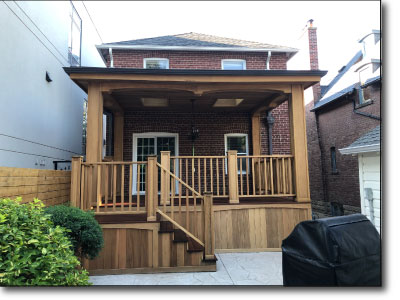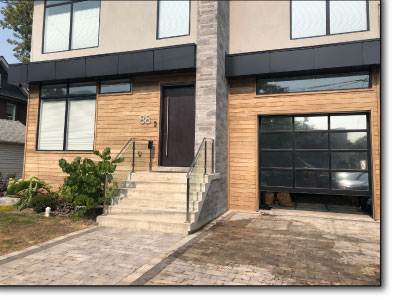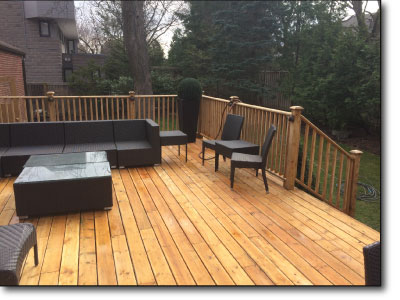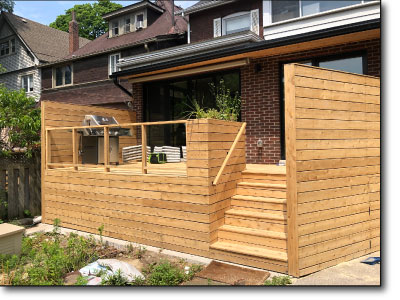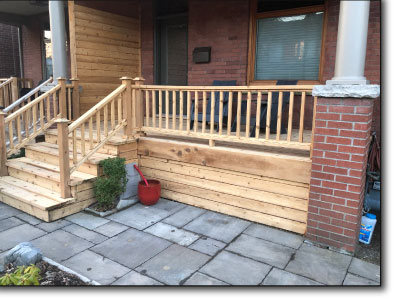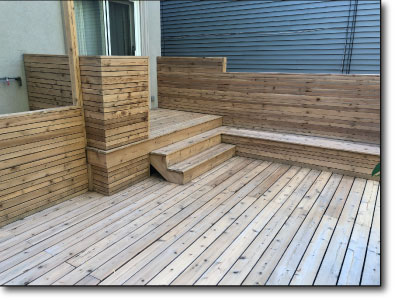Frequently Asked Questions
We aim to offer helpful and detailed advice for your specific project. If you can't find a specific topic, send us your questions and we will do our best to find the right information.
It's an enviro-friendly, very effective and affordable alternative to many commercial wood cleaners.
While other products are more specific to doing one or two tasks, ours is a universal wood cleaner that can perform in many different situations.
We have been relying on this cleaner for our own exterior wood projects for many years. Whether we are applying stain or oil, using this cleaner has always been the first step on each and every project.
Many commercial cleaners contain various chemicals such as Sodium Hydroxide, Phosphoric Acid, Bleach and many other ingredients that might cost less, but they all can damage your property if you're not super careful, especially around plants and other vegetation.
With any kind of cleaner, it's wise to pre-soak any plants and keep them wet to avoid detergents drying on the surface. The important thing is never to let any cleaner dry on the surface to avoid problems. Our cleaners are way less harsh and easier to work with compared to many others.
Usually not, but it depends on the amount of dirt or algae that you're trying to remove.
Although scrubbing will save on product usage, it can be a real pain and time consuming task. We opt to use more cleaner and let it really soak into the wood rather that scrub. But sometimes the algae are just so imbedded into the wood fibres that a little agitation is helpful.
You can use this cleaner on pretty much any exterior wood, as long as you have the means to rinse it thoroughly from the surface. It's always wise to do a test before using on an entire project, just in case there is a small chance the wood reacts negatively to the cleaner. If this ever happens, please send us photos and some details because we have never encountered this problem.
Absolutely. Using a garden hose at 40psi will never completely rinse off the dirt and cleaner. A minimum of 500 psi will do the job. Using a higher psi will increase the time needed but you have to be careful not to damage the wood.
Before staining or applying any finish product, it is imperative to first use our wood conditioner. If you don't, you are guaranteed to run into some problem with adhesion or longevity of your application.
That is a HUGE question that requires many details! Otherwise, using the wrong product on an outdoor structure can lead to thousands of dollars in repair costs.
We recommend using either of following tools to get the right product for your specific project.
OUTDOOR PRODUCT SEARCH for outdoor wood projects.
INDOOR PRODUCT SEARCH for indoor wood projects.
Always check the label and read the Manufactures Instructions because sanding will always be mentioned. If you insist on disobeying the product creators, then you might want to try experimenting on an extra piece of wood.
As a rule of thumb, if you intend on using a sealer or anything with pigment, sanding is always necessary.
The easiest test is by placing a few drops of water on the surface and observe if the water soaks into the wood or not.
For softwoods such as cedar, use a Green 25 degree tip. For hardwoods such as Ipe or Tigerwood, you may try a Yellow 15 degree tip.
A Yellow tip may be used for all types applications to save time, but only an experienced technician should try this. Using the yellow tip at further distances from the wood may sometimes also require engine speed reduction.
It all comes to the quality of the existing lumber and if you intend of performing regular maintenance.
ie. If you have 5/4" cedar in a high UV area and you don't plan to take care of it for several years, it may not be worth protecting it at all. Once the wood gets soft/spungy edges, sealers or stains will have little effect other than aesthetics.
The less sanding, the better! Use whichever sander gets the job done and takes the least amount of wood off. Using belt and drum sanders makes complete sense to save on labour, but if you intend on sanding with such aggressive tools every few years, there won't be any wood left to sand by the 3rd or 4th application.
As a rule of thumb, any spongy wood is not worth protecting and will need replacing soon enough. If the wood is in relatively good shape and can be cleaned and sanded, leaving a nice surface, it may be well worth a try. If the floor or stairs feel unsafe, railings are wobbly, those may be a sign that the structure is at the end of it's life.
There are two parts to that question.
1. If the wood is exposed to direct sunlight, be very cautious. Feel the wood and if it's hot to the touch, we highly advice not to apply any product.
2. Even if the wood is in the shade, ambient temperatures will affect the quality of the products. ie. If the humidity is very high and temperatures reach 35 degrees, we recommend holding off until it cools down a bit.
On any outdoor project exposed to the sun, we do not recommend using anything greater than 80 grit. Otherwise, the wood is too smooth and will not absorb the maximum amount of product.
Whether it is cedar, PT or another type of wood, always do a test. ie. Using less than 60 grit on Ipe may leave noticeable swirls on the surface and require a less aggressive approach.
It depends on a few variables. If the board is nailed down, you will need use a nail puller. If it's screwed in from the top and the screws are borken or rusted, then either use a nail puller or good old fashioned buchery. If the boards were screwed from underneath, then you're in for a major project and should watch some videos on Common Carpentry Repairs
It depends on the quality of the finished product.
If you're planning to spray the new paint and want a mint finish, you're going to have to remove the existing paint. Otherwise, there may be noticeable inconsistencies on the surfaces.
It is probably less expensive to replace all the doors compared to the amount of time to strip the paint, sand and play around with other chemicals to get it back to bare wood.
If quality isn't as important and you plan to cut and rool the new paint just to freshen it up, then you might want to try a test on one door before proceeding.
Absolutely YES. Assuming that the veneer has not been previously sanded, there are two approaches you can take.
1. An oil based stain will absorb but the surface has to be mint. Likely need a pre-stain conditioner as well.
2. A gel stain may hide small imperfections but will conceal some wood grains.
To start, it's usually easy to distinguish the difference by the weight of the wood. Solid wood weighs more.
Always inspect the end grains if visible.
UV exposure is the primary factor when choosing products.
If the doors is in constant sunlight, using a clear UV sealer as opposed to stain will dramatically reduce future labour costs.
If there is an existing stain, unless you are prepared (or even able) to get it down to bare wood, you will likely need restain it and apply a clear UV protector annually.
Not much at all! If the surface is not flat or shows any signs of previous sanding, your options are limited.
If you cannot sand, using chemicals would be the only way if you want to see the bare wood. Otherwise, using a really good primer and painting the surface would be the other option.
It depends on who's using the tools and if they take care of them.
Let's be honest, if your employees are using them, they probably don't care, so buy the cheaper brands! The parts on an orbital sander that wear out are the velcro and the round pad itself. Even the most expensive sanders use the same velcro. If the machine is still in tact, the pads can be replaced.
If you plan on using the sander for yourself and will take care of it, buy the good brands. The pads are built with better materials and there is a vacuum attachment rather than a pouch.
For wood cleaning purposes, we highly recommend gas units.
Gas units do a much faster job. It is way too easy to make mistakes with electric models. People will often get frustrated and tend to speed up the process by holding the wand too close to the wood, thus leaving many unsightly lap marks.
Dragging an electric cord all around is really annoying.
Electric units mostly use crappy pumps which don't last nearly as long compared to a decent gas unit.
It depends on what chemicals are being used.
Plastic models will almost always have pressure problems in a short time when using certain wood cleaners. ie. Stain strippers or other thick solutions.
If your budget can accomodate it, buying a metal sprayer is always a safe bet for many types of cleaners. They drastically cut down application time as well.
